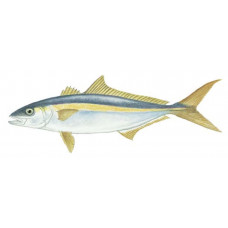Latin name
Seriola lalandi
Other names
Kingfish, yellowtail kingfish, king yellowtail, kingie, amberjack.
Identification
The body is elongated, not very tall, moderately compressed from the sides. The caudal peduncle is small, its length being just over 4 times the length of the head, and it has notches in front of the caudal fin above and below. The lateral line is elevated above the pectoral fin, then it follows horizontally along the midline of the body. There are no enlarged bony flaps in the lateral line. The scales on the body are very fine, cycloidal. The snout is conical. The mouth is terminal, weakly oblique. The upper jaw reaches the vertical of the middle of the eye. Posterior margin with rounded upper angle. Small conical teeth arranged on jaws in broad bands. The eyes are small. The first dorsal fin is lower than the second dorsal fin, and consists of spiny rays connected by a webbing. The soft part of the anal fin is noticeably shorter than the soft part of the second dorsal fin. The pelvic fins are noticeably longer than the pectoral fins. Yellowtail is easily distinguished by the deeply forked bright yellow caudal fins. The body coloration changes from purple-blue on the back to silvery-white on the belly. A copper-colored band runs the entire length of the body from the mouth to the tail. There is a small keel on either side of the caudal process.
Distribution
Occurs in all oceans. In the Atlantic, it is known off the coast of Brazil and northern Argentina, near St. Helena, off the coast of Africa south of Angola. In the Indian Ocean, it is found in Southern Africa, north of Natal, in Australia. In the Pacific Ocean - south of southern Japan, the Yellow Sea, everywhere near Australia, in the eastern part of the ocean - from British Columbia to Chile.
Habitat
It inhabits both pelagic and near-bottom horizons on the shelf and in the breakwater area, usually at depths of no more than 200 m. Yellowtail are predominantly coastal schooling fish, inhabiting coastal waters and up to the continental shelf. In addition to being found on and around offshore reefs and rocky shores, they often enter deep water around marinas, jetties, and artificial structures such as shipwrecks or artificial reefs. They occasionally swim along ocean beaches and into large estuaries. Large specimens, especially of the southern variety, are found in deep water around rocky pinnacles.
Size
The southern yellowtail is believed to reach a maximum weight of 154 pounds and a length of over 61⁄2 feet. The 114-pound southern yellowtail from New Zealand is the world record holder for all tackle. The world record for California yellowtail is nearly 79 pounds, but the average fish is much smaller.
Life history and Behavior
Yellowtail can form large aggregations around reefs and come to the surface massively to feed on clusters of baits and to drive bait to shore. Their migratory habits are not well known, but larger individuals are thought to be less migratory.
Food and feeding habits
Yellowtail will eat whatever is available. Gathering in groups, hunts for small fish (sardines, anchovies, mackerel, etc), also eats squid and pelagic crabs.
Reproduction
Spawning takes place during the summer months.
| Classification | |
| Phylum | Chordata |
| Class | Actinopterygii |
| Squad | Carangiformes |
| Family | Carangidae |
| Genus | Seriola |
| Species | S. quinqueradiata |
| Features | |
| Conservation status | Least Concern |
| Habitat | Pelagic |
| Life span, years | 12 |
| Maximum body weight, kg | 40 |
| Maximum length, cm | 150 |
| Sailing speed, m/s | No information |
| Threat to people | Edible |
| Way of eating | Predator |
Yellowtail
Tags: Yellowtail


